
Dr. Christoph Weiss has formed companies from a diverse range of situations in his career: advisor, restructuring manager, corporate manger, and proprietor. As CEO of C & E Fein GmbH, he has worked with the support of Staufen AG to focus more closely on the indirect areas. In a discussion with Christian Möllers, a partner at Staufen AG, he explains how they went about raising efficiency potential there.


DR. CHRISTOPH WEISS
is CEO at FEIN, a tool manufacturing company. He holds a doctorate in business administration and, inter alia, served on the board of Festo AG and managed the Theo Müller group of companies (Müllermilch). Weiss is also the proprietor of the jewelry manufacturer Ehinger Schwarz and the Zurich-based consulting firm 10-P Consult.
Dr. Weiss, the field of indirect areas ranges from R&D, HR, to Sales, to name just a few. Is there anything that these areas have in common?
Well yes. In each area, complexity is the main cost driver. We are living in times of hyper-competition. Everyone is doing their best to always offer their customers only the very best. Yet, that simply does not work.
What can we do to reduce the level of complexity?
By giving some thought to which target groups to serve with what kind of offer. Or more importantly: which target groups should no longer be served. This is exactly the question that so many companies are struggling with. Shortly after I started at FEIN, we pulled out of 60 small markets to focus on our own 15 national companies. That eliminated quite a bit of complexity on the sales side, and all of a sudden we had enough capacity there to generate completely different numbers of units in those markets that we consider critical, instead of having to tediously drum them up from around the world.
What will happen in the indirect areas after the strategy has been streamlined?
They will need to analyze exactly which processes have not yet been standardized. Ultimately, they are the biggest capacity guzzlers and thus the source of inefficiency. Many companies still believe that only they understand how their industry works. However, if you look at state-of-the-art ERP solutions, you can see just how many processes can now be standardized and more importantly, digitalized.
Do you have an example of a typically non-standardized and thus inefficient processes?
If a series manufacturer suddenly tries to offer customized solutions or services, it won’t be able to do so with its existing ERP. So what happens? They start tinkering with Excel workarounds. As a result, the entire operation runs counter to productivity.
What about processes that can’t be standardized, that I can’t shut down or outsource?
You can’t really standardize product management. At the same time, though; it is of paramount importance. After all, this is where creative minds look very closely at what customers need and how the market is developing. To keep productivity at a high level and not waste capacity, the only thing that helps is to strictly filter product ideas very carefully and manage the portfolio of the current product range.
The art of product management is to identify the customer’s problem and then weave a solution that is better than anything available on the market. But to do this, you have to think outside the box and then inside the box. Product managers are expected to be the entrepreneurs inside the company.
It would almost seem that the efficiency problems in the indirect areas are not being resolved because management is shying away from the upstream major moves and sometimes painful cuts.
I can only underscore that. Management does need to make clear directional decisions and give clear guidance to its staff: What is important and what should we leave out.
What key indicator do you use to measure whether an indirect area is operating efficiently?
My favorite indicator is the cost of human resources in relation to value added. Over time, the relative cost block per unit must be reduced. This is not achieved by pushing staff to work harder and faster, but instead by identifying the major cost drivers and learning to control them.
What is the minimum benchmark that companies should strive to achieve here?
If we add the total payroll costs (by adding direct and indirect areas) to the value added – i.e., sales minus material, minus extended workbench – we would come to the following scale for the manufacturing industry:
• Below 40 percent is excellent,
• Below 50 percent is good,
• Between 50 and 60 percent there is still plenty of room for improvement, and
• Above 60 percent becomes existentially dangerous.
Most importantly, this key figure is reflected 1 to 1 in the EBIT margin. Many people still do not realize this. The indicator payroll costs in relation to added value clearly indicates whether my company can expand without growing.
So it’s about creating greater value with the existing workforce.
If the working environment is inspirational and people are able to bring their own ideas to bear in improving processes, you have the essential ingredients for a company to continually get better and better. This is how you then succeed in achieving double-digit growth without requiring double-digit increases in the number of people you employ. My rule of thumb: 10 percent annual growth with 3 percent higher payroll costs is realistic if you manage it the right way.









